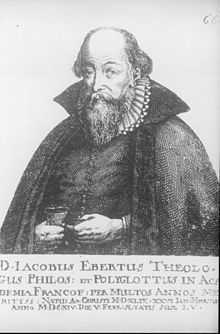Du Friedefürst, Herr Jesu Christ, BWV 116
| Du Friedefürst, Herr Jesu Christ | |
|---|---|
| BWV 116 | |
| Chorale cantata by J. S. Bach | |
 Jakob Ebert, the author of the hymn | |
| Occasion | 25th Sunday after Trinity |
| Performed | 26 November 1724 – Leipzig |
| Movements | 6 |
| Cantata text | anonymous |
| Chorale | by Jakob Ebert |
| Vocal | SATB choir and solo |
| Instrumental |
|
Du Friedefürst, Herr Jesu Christ (Thou Prince of Peace, Lord Jesus Christ), BWV 116, is a church cantata written by Johann Sebastian Bach in 1724 in Leipzig for the 25th Sunday after Trinity. It was first performed on 26 November 1724. The cantata is based on the hymn by Jakob Ebert (1601).
History and text
Bach wrote the cantata in 1724 for the 25th Sunday after Trinity as part of his second annual cycle of mostly chorale cantatas. The prescribed readings for the Sunday were from the First Epistle to the Thessalonians, the coming of the Lord (1 Thessalonians 4:13–18), and from the Gospel of Matthew, the Tribulation (Matthew 24:25–28). The cantata text of an unknown author is based exclusively on the chorale in seven verses of Jakob Ebert (1601). The first and last verse in their original wording are movements 1 and 6 of the cantata, verses 2 to 4 were transformed to movements 2 to 4 of the cantata, and verses 5 and 6 were reworded for movement 5. The chorale is in a general way related to the gospel.[1]
Bach first performed the cantata on 26 November 1724, which was that year the last Sunday of the liturgical year.[1]
Scoring and structure
The cantata in six movements is scored for soprano, alto, tenor and bass soloists, a four-part choir, horn, two oboes d'amore, two violins, viola, and basso continuo.[1]
- Chorale: Du Friedefürst, Herr Jesu Christ
- Aria (alto): Ach, unaussprechlich ist die Not
- Recitative (tenor): Gedenke doch, o Jesu
- Trio (soprano, tenor, bass): Ach, wir bekennen unsre Schuld
- Recitative (alto): Ach, laß uns durch die scharfen Ruten
- Chorale: Erleucht auch unser Sinn und Herz
Music
The opening chorus is a chorale fantasia, the soprano singing the cantus firmus and a horn playing the melody. It is embedded in an orchestral concerto with ritornellos and interludes, dominated by the concertante solo violin. The treatment of the lower voices differs within the movement. In lines 1 and 2 and the final 7 they are set in homophonic block chords, in lines 3 and 4 they show vivid imitation, in lines 5 and 6 their faster movement contrasts to the melody.
The alto aria is accompanied by an oboe d'amore, equal to the voice part, expressing the soul's terror imagining the judgement.[2] The following recitative begins as a secco, but the idea "Gedenke doch, o Jesu, daß du noch ein Fürst des Friedens heißest!" (Yet consider, o Jesus, that you are still called a Prince of Peace!), close to the theme of the cantata, is accompanied by a quote of the chorale melody in the continuo.
Rare in Bach's cantatas, three voices sing a trio, illustrating the "wir" (we) of the text "Ach, wir bekennen unsre Schuld" (Ah, we recognize our guilt), confessing and asking forgiveness together.[2][3] It is accompanied only by the continuo. The following recitative is a prayer for lasting peace, accompanied by the strings and ending as an arioso.
The closing chorale is a four-part setting for the choir, horn, oboes and strings.[1]
Recordings
- Bach Cantatas Vol. 5 – Sundays after Trinity II, Karl Richter, Münchener Bach-Chor, Münchener Bach-Orchester, Edith Mathis, Trudeliese Schmidt, Peter Schreier, Dietrich Fischer-Dieskau, Archiv Produktion 1978
- Die Bach Kantate Vol. 58, Helmuth Rilling, Gächinger Kantorei, Bach-Collegium Stuttgart, Arleen Augér, Helen Watts, Lutz-Michael Harder, Philippe Huttenlocher, Hänssler 1980
- J.S. Bach: Das Kantatenwerk – Sacred Cantatas Vol. 6, Nikolaus Harnoncourt, Tölzer Knabenchor, Concentus Musicus Wien, boy soprano, Paul Esswood, Kurt Equiluz, Philippe Huttenlocher, Teldec 1981
- J.S. Bach: Complete Cantatas Vol. 12, Ton Koopman, Amsterdam Baroque Orchestra & Choir, Sibylla Rubens, Annette Markert, Christoph Prégardien, Klaus Mertens, Antoine Marchand 2000
- Bach Cantatas Vol. 9, John Eliot Gardiner, Monteverdi Choir, English Baroque Soloists, Katharine Fuge, Nathalie Stutzmann, Christoph Genz, Gotthold Schwarz, Soli Deo Gloria 2000
- J.S. Bach: Cantatas Vol. 28, Masaaki Suzuki, Bach Collegium Japan, Yukari Nonoshita, Robin Blaze, Makoto Sakurada, Peter Kooy, BIS 2004
References
- ↑ 1.0 1.1 1.2 1.3 Dürr, Alfred (1981). Die Kantaten von Johann Sebastian Bach (in German) 1 (4 ed.). Deutscher Taschenbuchverlag. pp. 255–527. ISBN 3-423-04080-7.
- ↑ 2.0 2.1 Thompson, Simon (2009). "Bach: Cantatas Vol 9 / Gardiner, English Baroque Soloists". ArkivMusic. Retrieved 9 November 2010.
- ↑ Gardiner, John Eliot (2009). "Cantatas for the Eighteenth Sunday after Trinity / Thomaskirche, Leipzig" (PDF). Bach Cantatas Website. pp. 14–16. Retrieved 1 November 2010.
Sources
- Du Friedefürst, Herr Jesu Christ, BWV 116: Scores at the International Music Score Library Project
- Cantata BWV 116 Du Friedefürst, Herr Jesu Christ history, scoring, sources for text and music, translations to various languages, discography, discussion, Bach Cantatas Website
- BWV 116 – "Du Friedefürst, Herr Jesu Christ" English translation, discussion, Emmanuel Music
- Du Friedefürst, Herr Jesu Christ history, scoring, Bach website (German)
- Du Friedefürst, Herr Jesu Christ, BWV 116 English translation, University of Vermont
- Du Friedefürst, Herr Jesu Christ, BWV 116 text, scoring, University of Alberta (German)
- Chapter 26 BWV 60 O Ewigkeit, du Donnerwort / Oh, eternity, word of thunder. Julian Mincham, 2010
| ||||||||||
|